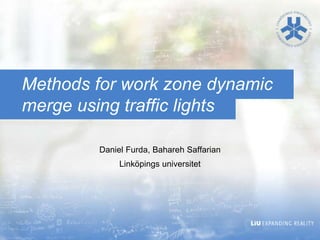
Session 20 Daniel Furda, Bahareh Saffarian
- 1. Methods for work zone dynamic merge using traffic lights Daniel Furda, Bahareh Saffarian Linköpings universitet
- 2. Definition A segment influenced by works on, near or above it 2
- 3. Work zone classifications • Duration of the work • Type of the interaction between road and the work zone • Work intensity 3
- 4. Work zone Layouts • Advanced warning area • Transition area • Working(activity) area • Termination area Advanced Transition Activity Termination Warning Area Area Area Area 4
- 5. Work zone impacts safety Work zone cost mobility impacts Environ- mental 5
- 6. Work zone traffic performance analysis • Mobility analysis( V/C, LOS, travel time delay) • Safety analysis • Delay and cost analysis 6
- 7. significant influential factors • Heavy vehicle percentage • Number of open and close lanes • Work intensity • Position of closed lanes • Weather conditions • Lane width • Ramp distance • Temporary speed limit • Work zone length 7
- 8. Dynamic Merge Systems Early Merge Late Merge 8
- 9. Experiment • Microsimulation – Aimsun • Late merge metering • Control through traffic lights 9
- 10. Calibration of the model • Driver reaction time = 0,5s • Driver reaction time at stop = 0,7s • Driver reaction time at lights = 0,7s 10
- 11. Layout of the work zone Occupancy detectors Traffic ligths 20m 100m 11
- 12. Assigned flow 3500 3000 2500 Flow 2000 (veh/h) 1500 1000 500 0 15 30 45 60 75 Simulation time (min) 12
- 13. Scenarios • ALINEA metering system • Fixed cycle times • Continuous merge metering 13
- 14. ALINEA Occupancy detectors Traffic ligths Controler 14
- 15. Alinea 4s 3s Variable Lane 1 Lane 2 Time 15
- 16. Fixed cycle times Cycle time (s) 15 15 Lane 1 30 Lane 2 30 30 Lane 1 60 Lane 2 60 60 Lane 1 120 Lane 2 Time 16
- 17. Continuous metering 1 1 Lane 1 Lane 2 Time 17
- 18. Fixed cycle times Mean Queue Delay Time per Length (veh) Vehicle (s) 350 300 300 250 Alinea 250 200 Fixed 120 200 150 Fixed 60 150 100 Fixed 30 100 50 Contin 50 No control 0 0 5 15 25 35 45 55 65 75 85 95 5 15 25 35 45 55 65 75 85 Simulation time (min) Simulation time (min) 18
- 19. Conclusion • Extensive sensitivity analisys • Evaluate the effect of lane-changing restrictions • Calibration and validation of the model 19
- 20. www.liu.se
Editor's Notes
- Work zone, in general, can be defined as a part of a road facility influenced by a construction activity occures on, near or above it. The difinition also includes the complete section of the road containing different road work traffic controls and equipments.
- They can be classified based on different factors such as the duration of the work ( long, intermediate, short, short duration and mobile), type of interaction( off roadway and on road ways) and work intensity( lightest, light, moderate, heavy, very heavy and heaviest)
- A work zone normally is a combination of four general parts. The firat part of a work zone is called advanced warning area in which the info about the upcoming work zone are given to the road user by means of regular sequences of sign, messages and control devices.The second part is the transition areawhich is between the advanced area and the start of the actual work where drivers are led to the open lane. The third part is the actual area that the activity is taking place and finally the termination area where the traffic is returned to the basic road condition.